Engagement Ring Styles: How to Choose a Ring
The engagement ring needs to fit her personal style. Read this guide for the different types of engagement ring settings you should know before you buy a diamond.
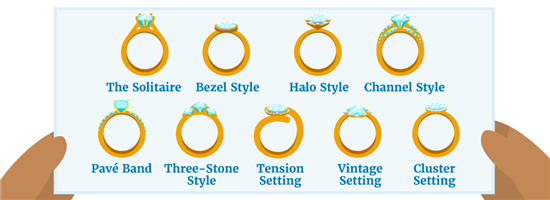 |
| © CreditDonkey |
When shopping for an engagement ring, most people put their focus on the diamond. After all, this is the most eye-catching - and expensive - part of the ring.
But did you know - 88% of brides actually say they care more about the overall design of the ring. They want a ring that matches their personal taste and lifestyle.
Some girls prefer a simpler style, while others prefer something more flashy. And some engagement ring styles can even make the diamond appear larger, which is good for smaller budgets.
Learn about the nine most popular engagement ring styles and their pros and cons so you can decide which is best for you.
- Traditional: A classic solitaire is timeless and shows off the diamond.
- Elegant: A pave setting adds just the right touch of sparkle on the band.
- Vintage: A geometric halo is reminiscent of the Art Deco period.
- Sentimental: A three-stone setting represents the past, present, and future of the relationship.
- Trendy: A tension setting is contemporary and eye-catching.
- The Solitaire
- Bezel Style
- Halo Style
- Channel Style
- Pavé Band
- Three-Stone Style
- Tension Setting
- Vintage Setting
- Cluster Setting
- Custom Style
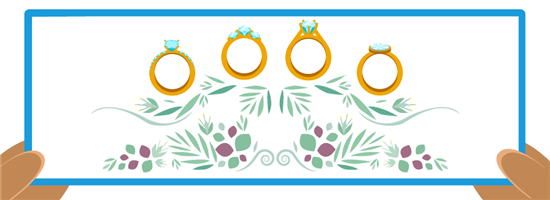 |
| © CreditDonkey |
The Solitaire
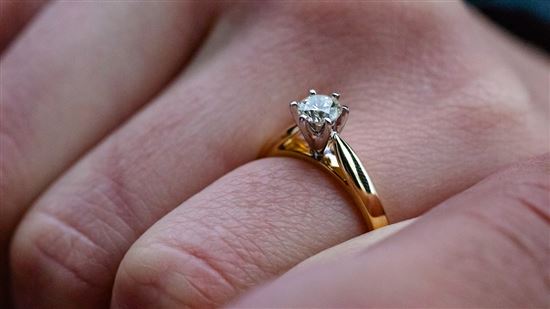 |
The solitaire is timeless and classic. You may also hear it called a "prong setting," as the stone is raised high with prongs.
Several prong styles are available, depending on the shape of the stone in use. For example, round diamonds typically use either 4 or 6 prongs, while princess cut diamonds have 4 V-shape prongs in each corner.
- Pros: The solitaire setting supports the stone high above the ring. This lets the stone be the center of attention and even makes it appear larger. Light passes through the entire stone, creating a higher level of sparkle and brilliance.
- Cons: Because the stone sits high above the ring, it's easier to snag the diamond on clothing or bang it against things. This may bend or break the prongs at some point, potentially causing you to lose the diamond. It'll need to be inspected frequently for damaged prongs.
- Best for: The classy, traditional girl.
Bezel Style
A bezel setting has a metal rim that surrounds the diamond. It has a very contemporary look. Most bezel styles are seen with a round diamond, though it can be made to accommodate any shape stone.
- Pros: The bezel secures the diamond with a metal rim. So active girls who work with their hands a lot will appreciate the added security. The bezel also makes the ring smooth, so it's also good for girls who work with kids (such as teachers, childcare providers, and nurses).
- Cons: You only see the top of the diamond as a large chunk of the stone is covered with metal. This doesn't allow as much light to pass through, so the diamond may not seem as brilliant.
If you don't like this design but want a more secure setting, you can consider a partial bezel that only goes around two sides.
- Best for: Active girls and those who work with children.
Example of a Bezel Style Engagement Ring
Halo Style
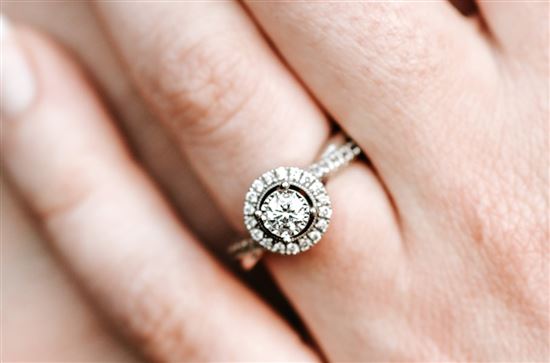 |
The halo setting has a ring of small diamonds around the center stone. It has a vintage yet elegant look. There are many different types of halo styles that can give completely different looks. For example, there are single, double, or even triple halos. Or halos with a geometric shape. Or halos with different colored gemstones.
This style has the most customization potential. If you're interested in the halo, take some time to study all of the different designs to find one you like the most.
- Pros: From a distance, the halo style can make the main diamond seem extremely large. It's the best setting for making a big impact on a small budget. You can buy a smaller center stone, put a halo around it, and have it look much larger. And because of all the small diamonds, it also has massive bling factor.
- Cons: The small diamonds can overwhelm or detract from the main stone. Some people think it's too flashy and looks like costume jewelry. You may also lose a small diamond at some point.
- Best for: Small budgets and girls who like major sparkle.
Channel Style
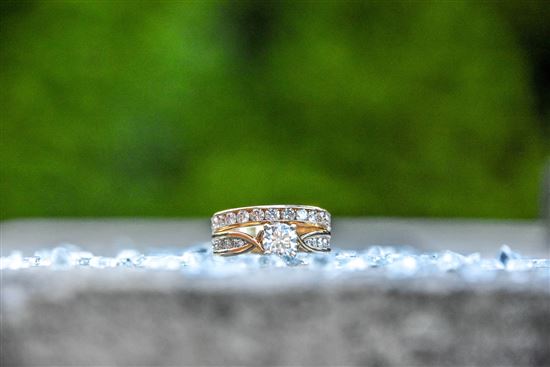 |
The channel style of engagement ring has small diamonds set in a row in the band. They're set in a metal "channel" flush with the surface of the band. It gives the band some extra sparkle.
- Pros: The metal channel secures the small diamonds so they're not likely to fall out. And since they're flush with the surface, it means they won't snag on clothing either.
- Cons: Dirt and debris can become caught between the small diamonds and the metal, so this setting will require more cleaning. Also, it's hard to resize a channel setting since the small stones can loosen or become misaligned.
- Best for: Semi-active girls and elegant girls.
Pavé Band
The pavé setting also has small diamonds in the band, like the channel setting style. However, instead of set in a channel, the small diamonds are set next to each other directly on the band using beads, so you see very little metal. You can have multiple rows of tiny stones on the band, or just one row of stones for a thin, delicate look.
- Pros: This setting makes the band super sparkly since all you see is a line of diamonds. These tiny stones also draws attention to the main center stone.
- Cons: You can lose one of the small stones if you're super active with your hands.
- Best for: Girls who want a little extra sparkle.
Three-Stone Style
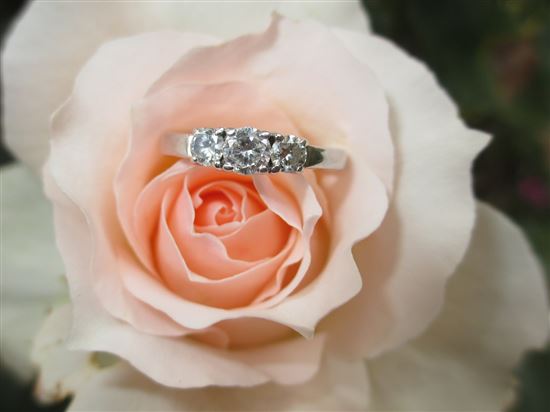 |
The three-stone setting consists of a main large diamond in the center, accompanied by two stones on either side. Usually, the two side stones are a little smaller, but some people choose to make all three stones almost the same size.
The three stones represent the past, present, and future of the relationship.
- Pros: This setting a great way to personalize a ring. You can place meaningful gemstones around the main diamond. Or if you don't have the budget for a large center stone, you can still achieve a greater surface area combined among the three diamonds. Three smaller diamonds cost a lot less than one large diamond.
- Cons: Not everyone likes this look, as the main diamond doesn't pop out.
- Best for: The sentimental girl.
Tension Setting
The tension setting is modern and artsy. The stone is held in place using pressure between the two metal ends. When done correctly, the tension ring almost seems as though the diamond is floating between the two pieces of metal.
- Pros: Because so little metal actually comes in contact with the diamond, as much light as possible strikes the stone, giving it great brilliance. The suspended stone also gives the ring a very unique, contemporary look.
- Cons: A blow in the right direction could knock the stone loose, though the chances are low. This setting is almost impossible to resize since the stone is held in place by a perfect pressure. So make sure you get it custom fitted or know the exact size before buying.
- Best for: The modern trendsetter.
Example of a Tension Style Engagement Ring
Tip: If you like this look but are worried about the stone popping out, there's also a tension style setting. In this style, the stone is better secured in place with prongs or a bezel around the diamond. This gives the ring the look of the classic tension setting, but the diamond has less chance of popping loose.
Vintage Setting
Vintage style engagement ring settings are great for someone who wants a unique look with charm. Vintage style rings are inspired by the different time periods, such as Art Deco or the Victorian era.
Often, they have a lot of intricate metal work, including metal beading, scroll details, or geometric shapes. You also may see a lot of halo or pavé elements.
- Pros: Vintage rings are very unique and make a bold statement.
- Cons: The minute details in the design of this ring can make it tougher to clean.
- Best for: Vintage lovers.
Cluster Setting
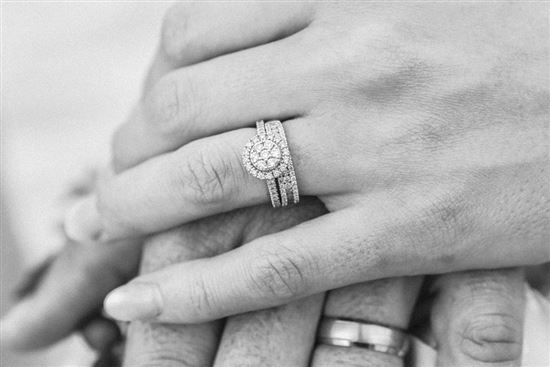 |
This is when many small stones are clustered together to look like one larger diamond. Because small diamonds are used, you can form a lot of unique designs and shapes. To see some examples of beautiful cluster rings, check out James Allen's Royal Halo collection.
- Pros: Cluster rings are good if you're on a very small budget. A lot of small diamonds are much less expensive than one single larger diamond. With this setting, you can achieve a larger surface area for a lot less. This is a good budget-friendly choice for girls with larger hands.
- Cons: A lot of small stones also mean a lot of crevices. So it can be harder to clean. Also be careful about a small diamond falling out.
- Best for: Small budgets and girls who want something unique.
Custom Style
The above is just the basics of each engagement ring style. You can always choose a setting that combines several styles. For example, you can have a halo ring with bezels around the center stone and halo, and a twist pavé band. The possibilities are endless.
Or if you have an artistic side or know exactly what you want, you can also design your own ring. Most jewelers will work with you to create your own custom design. If you're interested in a unique ring, this is the way to go.
Understand that there are some limitations in designing an engagement ring, as the jeweler needs to be able to securely attach the diamond to the ring, Any design you create has to be practical and trustworthy as well as beautiful … kind of like a good marriage!
Metal Choices
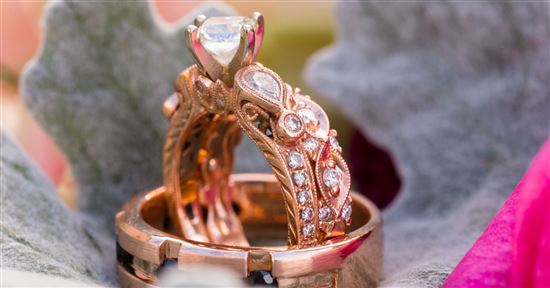 |
The color of the ring is also important to express the woman's style. Here are the most popular metal options and their pros and cons.
Platinum:
Platinum is the most expensive metal choice. It's naturally a silvery-white color and has a luxurious weighty feel. Platinum is very hard so it'll hold diamonds more securely in place. It's also hypoallergenic so it's good if you have sensitive skin.
However, despite being durable, platinum gets scratched easily and will need re-polishing often to maintain the shine.
White Gold:
White gold has an expensive platinum look, but costs a lot less. White gold is made by mixing gold with nickel, and then dipping the band in rhodium to create that silvery-white finish. This makes white gold more resistant to scratches and dents.
The downside is that you'll need rhodium re-plating every couple of years. Also, because of the nickel content, it may cause allergies if you have sensitive skin.
Yellow Gold:
Yellow gold is great for those who like warmer jewelry. It's easy to maintain since there's no rhodium plating. Another HUGE advantage is that it can accommodate diamonds lower in color, so you can save some money in that area.
But it's the softest and least durable metal, so it's most easily scratched and dented.
Rose Gold:
Rose gold is perfect for romantics and vintage lovers. Rose gold is made by mixing gold with copper to create the warm color. Because of the copper, this makes rose gold the hardest out of the golds. But the copper may also cause skin allergies for some people.
Band Styles
Besides the common engagement ring settings listed above, there are also a variety of band styles. Choosing a unique band will allow your ring to stand out even more. Some band styles include:
- Cathedral setting. This is a very elegant setting style. Instead of the band being a perfect circle shape, the band sweeps up to meet the diamond on either side (looking like the arches on a cathedral). This also makes the diamond a little more secure since the metal helps to keep it in place.
A cathedral setting can work with many styles, including solitaries, bezel, pave, channel, and halo.
- Split shank. Shank is another word for the band. A split shank is when the band splits into two as it reaches the center stone. This gives the band some extra width without looking too chunky.
It makes a good choice for girls with chubbier fingers, as the wider-looking band balances out wider fingers.
- Knife-edge. This style has a sharp edge around the band (instead of the usual rounded rings). This gives the band a clean thinner appearance, which really helps to make the stone pop more.
A downside is that wearers may find it slightly uncomfortable because of the sharp edge. The famous Tiffany setting has a knife-edge shank.
Bottom Line
The style of the engagement ring is important to express her personal style. The overall design of the ring is what people will notice first. This should be nailed down first before even thinking about choosing the diamond. The diamond should complement the setting.
Each type of setting has their own pros and cons. Some settings are great for smaller budgets. Some are better for active girls. And some require more maintenance. Consider budget, her personal tastes, and lifestyle when choosing the right setting.
Write to Kyle Schurman at feedback@creditdonkey.com. Follow us on Twitter and Facebook for our latest posts.
Note: This website is made possible through financial relationships with some of the products and services mentioned on this site. We may receive compensation if you shop through links in our content. You do not have to use our links, but you help support CreditDonkey if you do.
Read Next:

